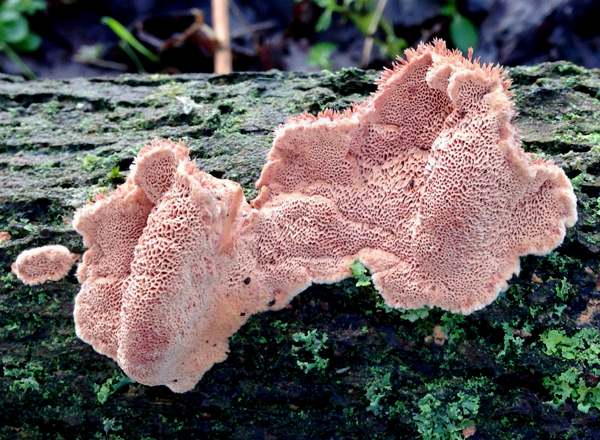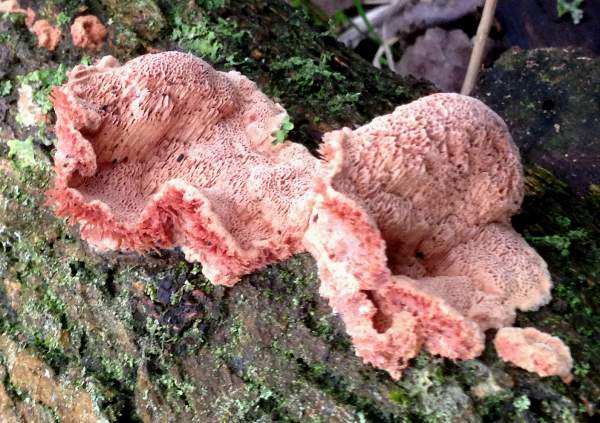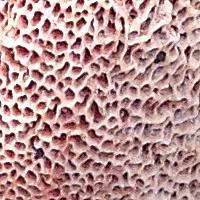Postia placenta (Fr.) M. J. Larsen & Lombard - Pink Pancake Crust
Phylum: Basidiomycota - Class: Agaricomycetes - Order: Polyporales - Family: Fomitopsidaceae
Distribution - Taxonomic History - Etymology - Identification - Culinary Notes - Reference Sources

This lovely but sadly all too rare polypore can be found on rotting stumps and fallen branches of coniferous trees, where separate fruitbodies expand and often fuse into large irregular patches.
Pine wood is the most common host to this wood-rotting polyporous fungus, which causes brown rot. The pink or orange fertile surface is particularly distinctive, although the physical form of fruitbodies, and in particular the shapes of the pores, are very variable.

In common with most resupinate fungi, this beautiful polypore tends to hide on the underside of fallen branches, so turning dead wood over often pays off; however, not only the fungi but also many small woodland creatures will benefit from having the timber returned to its original position and orientation.
Distribution
Formally recorded in Scotland and England, but very rare, this polypore is known throughout most of Europe except the Mediterranean region, but it is rare throughout its range. Postia placenta is more widespread and common in parts of North America, where it is a common cause of wood rot in ships, in mines (attacking pinewood pit props) and in the timber of buildings. I have seen a report stating that Postia placenta was accidentally imported to Britain by ship from America.
Many current field guides refer to this fungus as either Tyromyces placenta or Oligoporus placentus.
Taxonomic history
Although described scientifically as Boletus incarnatus as long ago as 1801 by Christiaan Hendrik Persoon, this beautiful polypore owes its basionym (first valid specific name) to an 1862 publication by the great Swedish mycologist Elias Magnus Fries. The currently-accepted scientific name Postia placenta dates from an 1986 paper in the journal Mycotaxon by American mycologists Michael J Larsen (1938 - 2000) and F F Lombard (no biographical details yet available).
Postia placenta has many synonyms including Boletus incarnatus (Pers.) Pers., Polyporus incarnatus (Pers.) Fr., Polyporus placenta Fr., Poria placenta (Fr.) Cooke, Tyromyces placenta (Fr.) Ryvarden, and Oligoporus placentus (Fr.) Gilb. & Ryvarden.
Etymology
Postia, the genus name, was established by Elias Magnus Fries in honour of the Swedish naturalist Hampus von Post (1822 - 1911). The specific epithet placenta means flat or slab-like (and is Latin for cake!).
Identification Guide
 |
CapOften entirely resupinate, so that all that is visible is the pore surface, this fungus is usually quite loosely attached to its substrate timber. Tubes and PoresThe pores are irregular but often roundish to angular; usually with some of the pores appearing almost labyrinthine or maze-like; pores and tubes are various shades of pink and spaced 1.5 to 4 pores per mm. |
SporesEllipsoidal, smooth, 5-6 x 2-2.5µm; inamyloid. Spore printWhite. |
|
Odour/taste |
Astringent odour (typical of Postia species); very little taste. |
Habitat & Ecological role |
In Britain this rare polypore is most often seen on pine wood, but it has also been recorded on Douglas fir and on larch. |
Season |
Late summer, autumn and (in mild years) early winter. |
Similar species |
Because of its unusual colour and relatively large pores, Postia placenta is unlikely to be confused with any other common polyporous fungus. Postia subcaesia and Postia alni, both most commonly associated with broadleaf trees rather than conifers, have pale bracket-like fruitbodies with a bluish tinge. Postia caesia grows on conifer wood; it has a blue tinge and forms brackets. Postia stiptica usually grows on conifer wood; it is white and forms brackets. |
Culinary Notes
These resupinate fungi are generally considered to be inedible.
Reference Sources
Ryvarden, L. 1973. Some genera of resupinate polypores. Norwegian Journal of Botany. 20(1):7-11
Olaf Schmid, 2010. Wood and Tree Fungi: Biology, Damage, Protection, and Use. Springer-Verlag Berlin and Heidelberg
Mattheck, C., and Weber, K. Manual of Wood Decays in Trees. Arboricultural Association 2003.
Dictionary of the Fungi; Paul M. Kirk, Paul F. Cannon, David W. Minter and J. A. Stalpers; CABI, 2008
Taxonomic history and synonym information on these pages is drawn from many sources but in particular from the British Mycological Society's GB Checklist of Fungi.
Acknowledgements
This page includes pictures kindly contributed by Simon Harding.
Fascinated by Fungi. Back by popular demand, Pat O'Reilly's best-selling 450-page hardback book is available now. The latest second edition was republished with a sparkling new cover design in September 2022 by Coch-y-Bonddu Books. Full details and copies are available from the publisher's online bookshop...

